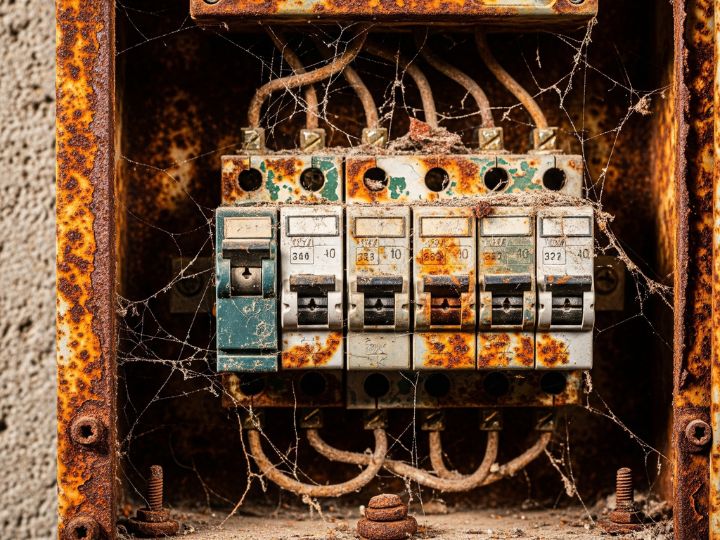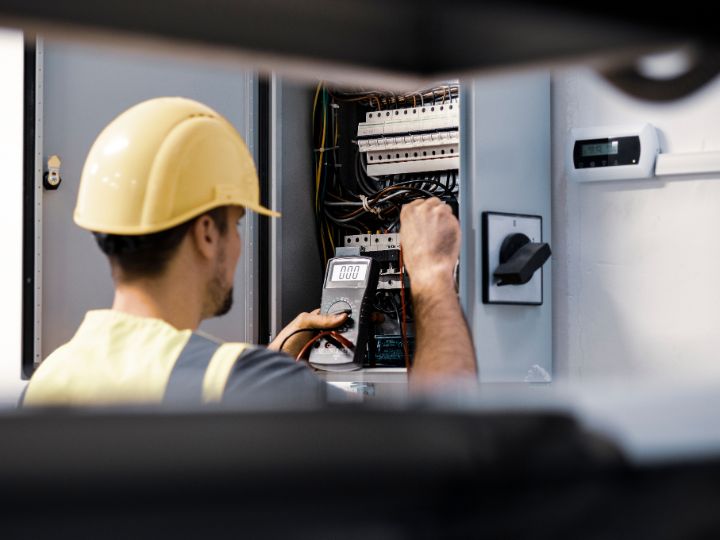When it comes to home electrical safety, outdated systems can hide serious threats. One alarming example is the 100-amp Pacific Electric panels fire risk—a hazard many homeowners overlook until it’s too late. These older panels, once common in mid-century homes, may no longer meet today’s safety standards, posing a silent danger behind your walls. In this blog, we’ll uncover the hidden fire hazards associated with these panels and explain why an electric panel upgrade could protect your home and loved ones.
Understanding the 100-Amp Pacific Electric Panel
Pacific Electric panels were commonly installed in homes between the 1950s and 1980s. While considered reliable at the time, these panels have not aged well in the context of modern safety standards and electrical load requirements. A 100-amp rating, once suitable for mid-20th century homes, is now grossly inadequate for the power-hungry appliances and technologies used today.
Key Fire Hazards of Pacific Electric Panels

1. Faulty Breaker Design
One of the most critical dangers associated with 100-amp Pacific Electric panels is their defective breaker mechanisms. These breakers are known to fail at tripping during electrical surges or overloads. When a breaker does not trip, the electrical current continues to flow through overloaded wires, generating excessive heat and increasing the risk of electrical fires.
2. Overloaded Circuits in Modern Homes
Today’s homes require more electricity than ever before. With the addition of HVAC systems, washers, dryers, electric ranges, multiple televisions, computers, and chargers, a 100-amp panel is stretched beyond its safe limits. This constant overloading not only leads to overheating of wires but also accelerates the wear of outdated components, increasing the likelihood of short circuits and combustion.
3. Degraded Internal Components
Decades of operation lead to deterioration of internal parts, including breaker contacts, bus bars, and wiring insulation. Pacific Electric panels often show signs of corrosion, rust, and moisture damage, all of which impair proper functioning. A corroded contact can result in arcing, where electricity jumps between connections, creating intense heat capable of igniting nearby flammable materials. This contributes to the serious Pacific Electric panel explosion danger that homeowners must not ignore.
Real-World Incidents and Recalls
Multiple reports have linked electrical fires caused by outdated 100-amp panels to Pacific Electric panels, raising serious concerns among homeowners and experts. While these panels have not been subject to a nationwide recall, many electricians and industry professionals strongly recommend replacing them due to the risk they pose.
Despite the absence of formal recalls, the danger remains significant. Insurance companies often view these panels as high liability risks, which can lead to denied coverage or increased premiums for homes that still rely on these outdated systems.
Identifying a Pacific Electric Panel in Your Home
To determine if your electrical panel is a 100-amp Pacific Electric model, look for the following indicators:
- The brand name “Pacific Electric” or “PE” stamped on the panel door.
- Stab-lok circuit breakers, which slide rather than snap into place.
- Rust or discoloration around the breaker panel.
- Frequent flickering lights, tripping, or power outages.
- A tangled or messy wiring layout within the panel.
If any of these signs are present, schedule a professional panel inspection immediately to evaluate your system’s safety and compliance with current code.
Modern Safety Standards vs. Pacific Electric Panels
The National Electrical Code (NEC) standards have evolved to include advanced protection systems that older panels like Pacific Electric models do not support. Newer panels must meet updated criteria for fault current interruption, load balancing, and surge protection. Pacific Electric units fail in all these areas, offering no integrated arc fault or ground fault protection—key safety features that reduce the risk of electrical fires in living spaces and bathrooms.
Dangers of DIY Repairs or Breaker Replacements
Attempting to repair or replace breakers in a Pacific Electric panel without professional assistance is extremely dangerous. The design of these panels often results in breakers that don’t seat correctly, creating loose connections. Loose connections can arc, spark, and ignite fires inside the panel box. Furthermore, the components are no longer manufactured, leading some to resort to counterfeit or secondhand parts that do not meet UL safety standards.
The Financial Risks of Keeping an Obsolete Panel
Maintaining a 100-amp Pacific Electric panel isn’t just a safety issue, but a financial liability. Many home insurance companies flag homes with these panels and may:
- Refuse to renew your policy.
- Charge higher premiums due to the increased fire risk.
- Deny claims in the event of fire if the panel is deemed the cause.
Additionally, resale value drops significantly when a home inspector identifies a Pacific Electric panel, making it a deal-breaker for potential buyers.
Recommended Action: Upgrade Your Electrical Panel
When to Upgrade
If your home still uses a 100-amp Pacific Electric panel, it is essential to upgrade immediately, especially if:
- You experience frequent breaker trips.
- You plan to renovate or install high-wattage appliances.
- You notice any signs of burn marks or heat on the panel.
Your home’s lighting frequently dims or flickers.
Benefits of an Electrical Panel Upgrade
Replacing your Pacific Electric panel with a modern 200-amp panel will provide:
- Greater capacity for appliances and future additions.
- Enhanced fire protection through arc-fault and ground-fault breakers.
- Code compliance and improved home insurance eligibility.
- Peace of mind knowing your family and property are safe after an electric panel upgrade.
The Importance of Professional Evaluation
Only a licensed electrician should inspect, assess, and replace electrical panels. Certified professionals will ensure:
- Proper load calculations for your home’s specific energy needs.
- Full compliance with state and local building codes.
- Safe disposal of the outdated Pacific Electric panel.
- A clean, organized, and clearly labeled new panel layout.
Who Should I Call for Professional Electrical Services?

When it comes to upgrading or replacing dangerous 100-amp Pacific Electric panels, professional help is non-negotiable. Trust only licensed experts who specialize in residential electrical services to ensure safety and compliance.
Call Electricians Service Team for:
- Certified and experienced electricians
- Accurate load calculations and code-compliant upgrades
- Safe panel removal and installation
- Transparent pricing and timely service
Don’t risk DIY mistakes—protect your home with expert electrical services from Electricians Service Team today.
Conclusion: Eliminate Fire Hazards Before It's Too Late
Don’t wait for sparks to fly before taking action. The disadvantages of 100-amp Pacific Electric panels are too serious to ignore—ranging from outdated safety features to an increased risk of electrical fires and denied insurance claims. These panels simply can’t keep up with modern electrical demands.
Upgrading your panel is a smart investment in your home’s safety, value, and long-term performance. Let certified professionals from Electricians Service Team handle the replacement and bring your system up to today’s code. Protect your loved ones and property before it’s too late.
FAQs
These panels are known for faulty breakers that often fail to trip during electrical overloads, increasing the risk of fire. They also lack modern safety features like arc-fault and ground-fault protection.
Look for the brand name “Pacific Electric” or “PE” on the panel door, and check for stab-lok breakers or visible rust. Frequent electrical issues like flickering lights or tripping breakers can also be indicators.
No, DIY repairs are extremely risky due to outdated designs and hard-to-find, unsafe replacement parts. Always consult a licensed electrician for proper evaluation and service.
Yes, most insurance companies favor homes with modern, code-compliant panels and may reduce premiums once the upgrade is complete. Keeping an outdated panel could result in denied claims or policy cancellations.
A 200-amp panel is the standard upgrade today, offering more capacity for modern appliances and improved safety. It ensures compliance with current electrical codes and better prepares your home for future power needs.





